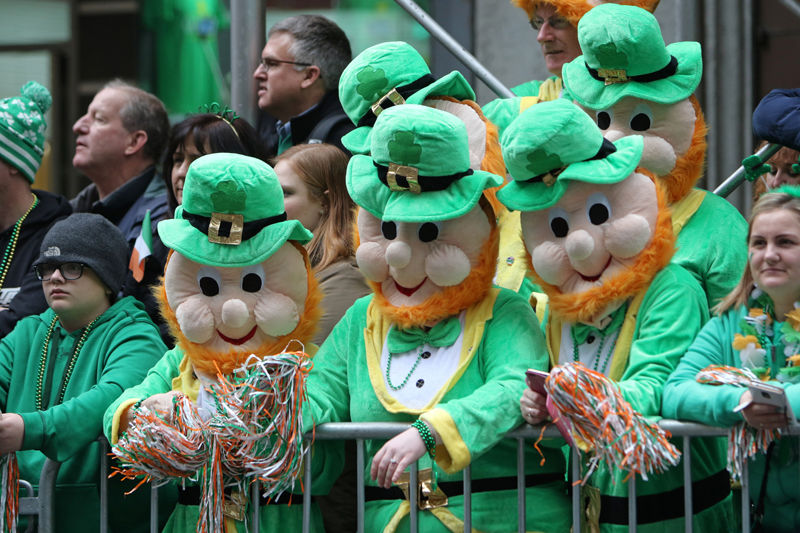I could probably be excommunicated for this mild form of blasphemy, but I am an Irish Catholic who does not care all that much for St. Patrick’s Day. More precisely, I don’t care much for what St. Patrick’s Day has become while at the same time harbor fond memories of a distant past.
All of this turns into a kind of cultural schizophrenia, which is further proof of my Irish heritage. It is a land, as they say, of happy war songs and sad love songs.
I do remember happily as a kid in parochial school at a time in the Archdiocese of Los Angeles where there were 50 kids to a classroom and two classrooms to every grade, and where each classroom was the domain of a nun in charge. It was the postwar high-water mark of both “the greatest” generation’s procreative prowess, combined with the flood of Irish born priests who seemed to helm every parish in the San Fernando Valley our family ever came across.
Lots of things were different then, and nothing as different as St. Patrick’s Day compared to the bacchanal it has come to be now. In the wondrous Catholic bubble I was privileged to grow up in, where I never met a divorced person, knew Protestants existed, but prayed for their conversion at the behest of some of those in charge nuns and generally basked in pre-Vatican II triumphalism, St. Patrick’s Day had a touch more reverence.
It also, thanks to all those FBI (Foreign Born Irish) pastors, was a day off school.
It was such a special day that the Disney corporation would offer special discounts on March 17, marketed as “Catholic Schools Day.” I recall in the weeks before St. Patrick’s Day when they would pass out those fliers in class about the discounted Disneyland tickets.
It was bittersweet as it intoned an impending day off, but also reminded me we never went to Catholic Schools Day at Disneyland, because our dad never got St. Patrick’s Day off unless it was a Sunday, and, even if he did, even “discounted” Disneyland tickets were an “E” ticket too far for us.
Still, I had a full day to myself and no school to worry about. If the 17th struck the calendar on a Friday or a Monday, then it meant an extended weekend and I could work out the calculus of how much longer I could defray facing any number of homework assignments.
And then there was the party. It was also one of my brother’s feast days and many times the extended family would gather to properly celebrate St. Patrick’s Day. Yes, we would put on silly green hats and yes there would be drinks for the adults and soda for us and chips and dip.
I hate admitting this, but we actually had a 78 rpm record of the “Irish Washerwoman,” which we would dance to in undisciplined and unartistic ways. But there was also a statue of St. Patrick on the dining room table. There would be a statue of St. Joseph two days later, though once again, the foster father of our Lord and Savior got the short end of the party stick.
I guess we played into a lot of the clichéd Irish stereotypes during our St. Patrick’s Day parties, but at least we were doing it within the confines of our home. And like the Bourbon and 7 that was the drink du jour, the Catholicity of the day was never watered down either.
In retrospect, it was probably a little too tribal for our own good, but I still miss it, and the fact this all happened in house and so many of the people it happened with are gone forever has bequeathed to me a perfect Irish melancholia.
Seeing the public displays of St. Patrick’s Day celebrations now it seems they are basically just an excuse for people to dress like fools, “celebrate” some of the lesser attributes of the Irish and compete with other “Kiss me I’m Irish” button-wearers in who-can-get-drunk-the-fastest contests. It’s a little ironic that in an age of such hyper sensitivity to all things politically correct, you can still dress like a leprechaun, speak in an exaggerated and incomprehensible Irish brogue, make light of the devastation of alcoholism and be celebrated on the evening news for it.
In the book “How the Irish Saved Civilization,” by Thomas Cahill, you’ll learn it was Irish clerics who saved the great works of Western Civilization during that very dicey transition between Roman Empire — Barbarians — Dark Ages thing. It is a story worth telling.
But in light of what St. Patrick’s Day has become, it might be important to remind people of another story — the Irish experience in America. This March 17 you won’t find it on the streets of New York or Los Angeles or inside bars between the cartoonish Irish tropes and off-key renditions of “When Irish Eyes Are Smiling.”
This story would be called “How One Man Saved the Irish in America.” That one man was an uneducated Irish immigrant who started out as a gardener and became the Archbishop of New York in the 1850s. He was Archbishop John Joseph Hughes (1797-1864) — his friends and his enemies knew him also as “Dagger” John. … Stay tuned.
Robert Brennan has been a professional writer for more than 30 years, including many years in the television industry.

